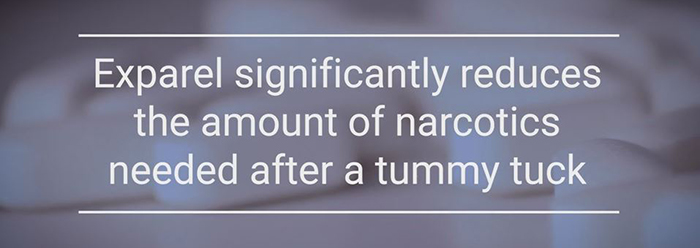Many moms are interested in learning about how a tummy tuck can to restore their stretched out abdomen to its pre-pregnancy condition. The interest often fades, however, when they hear stories of the traditionally lengthy and painful recovery. Thanks to several recent advances in plastic surgery, tummy tuck patients now have the opportunity to bounce back to normal life with very little downtime or pain.
“One of the gate keepers to people wanting to have this surgery done is the recovery,” shares Charlotte Plastic Surgery’s Dr. Stephan Finical. “We’ve made the recovery so much more pleasant. Now, people are back to activity, taking care of their families, doing the things that they feel like they need to be able to do to recover comfortably.”
Introducing a Long-lasting Anesthetic
The first three to four days after surgery tend to be the most painful. Today, plastic surgeons have a long-lasting anesthetic drug called Exparel available to ease pain in the early recovery period. Similar to a nerve block the dentist administers before an otherwise-painful dental procedure, Exparel is used to block the nerves of the abdomen during the procedure, offering up to 96 hours of pain control.
“We use ultrasound guidance so we can very, very precisely put it where the nerve endings are,” explains Dr. Finical. “The formal name for this is what is called a TAP block. We do that at the beginning of the surgery, once the person is asleep and it sets up during the time that we’re doing the operation. When they wake up, much of the area that we’ve worked on is completely numb.”
Less Pain Means Less Narcotics
Before Exparel, the most effective medications for keeping post-surgical pain under control were narcotic pain relievers. Unfortunately, dizziness, drowsiness, constipation and nausea are all very common side effects of narcotic pain relievers. Since Exparel, continues to work through the toughest period of the recovery, patients are now taking less narcotics to manage pain than they were in the past.
Side Effects of Narcotic Pain Relievers:
- Dizziness
- Drowsiness
- Constipation
- Nausea
“We did a study in our office, and we found that ladies who had Exparel used only a third of the amount of narcotics as they would normally use after a tummy tuck,” says Finical. “When you’re using less narcotics, there are less of those side effects that are really concerning to people as they recover.”
The Drawbacks of Surgical Drains
During a tummy tuck, the skin of the abdomen is lifted and re-positioned. This separation of the skin and fat from the deeper tissues creates an opening between the layers of the abdomen. Fluid tends to collect in this empty space after surgery as the body begins the healing process. Excessive swelling can slow the healing process, and fluid accumulation may lead to further, more serious complications.
Traditionally, surgeons would relieve the swelling by inserting clear plastic tubes into the empty space. These tubes allow the fluid to instead drain out of the body and into plastic bulbs.
Problems with Surgical Drains:
- Difficulty showering and dressing
- Pain at the drain exit site
- Nuisance to empty and track drainage
Many patients wake up from surgery and find themselves dealing with two or three drains for several days or even weeks. Surgical drains quickly become a nuisance to patients, making it difficult to shower and dress. “Drains are cumbersome to lug around and take care of in the post-op,” shares Finical. “And, a lot of times, where the drains leave the skin is the most tender part.”
In addition to being in the way and being uncomfortable, patients with drains must learn how to empty and track the drainage. Once the drainage output tapers off, the surgeon will remove the drains in the office.
Progressive Tension Sutures Instead of Drains
Instead of placing drains in the space beneath the flap of skin that was lifted and re-positioned, Dr. Finical secures the upper layer of fat and skin to the deeper layers, closing the gap with a special suturing technique known as progressive tension sutures. “There’s a lot of stitches that people don’t ever see, but they’re on the inside and they keep that flap held down against the muscular wall so we don’t need to use drains,” Finical explains.
Also known as quilting stitches, progressive tension sutures make it much easier for a person to take a shower the day after surgery. Patients are able to remove their their surgical garment or binder without the added hassle of dealing with dangling drains and drainage tubes.
Surgery and Back to Life
In Dr. Finical’s practice, drainless tummy tuck patients return to many of their regular activities of daily life the day after surgery. “They’re walking and mobile and comfortable. They can go up and down a flight of stairs, they can walk around the house,” he adds.
For the first few weeks he does ask his patients to limit their lifting to nothing heavier than about five pounds with either hand. While it won’t always be necessary, he also encourages his patients to give themselves a break from responsibilities, such as carpooling, for about two weeks.



















Facebook
Twitter
Instagram
YouTube
RSS